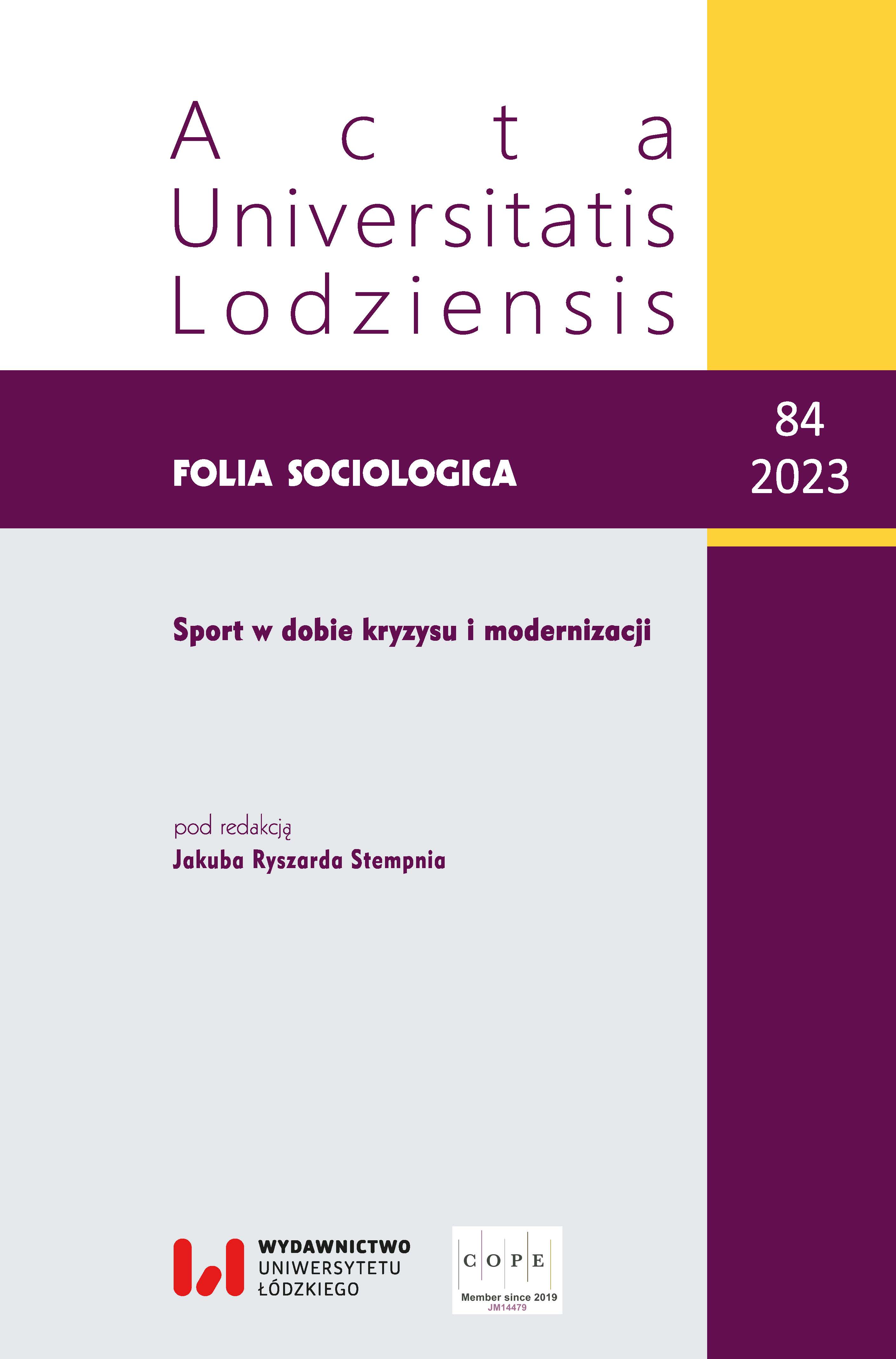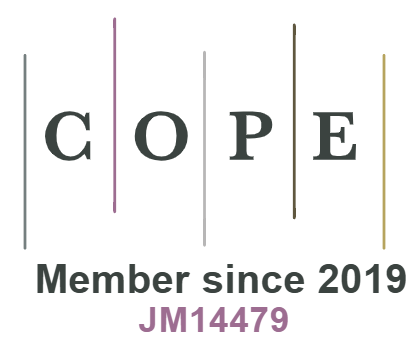Sport shooters in Poland: social capital of organizational engagement vs access to guns policy controversies
DOI:
https://doi.org/10.18778/0208-600X.84.06Keywords:
sport shooters, access to guns, social capital, sport organizations, organizational engagement, sport for developmentAbstract
The article presents sport shooting in Poland against a socio-political background. First, Polish society after the anti-communist breakthrough is diagnosed as a country lacking social capital and social trust in particular. In this context, membership in sport clubs, treated as a form of social involvement, is very desirable, as it expands the network of social cooperation. However, being a sport shooter is also associated with access to weapons, which is always controversial, even if Poland has low rates of access to firearms for citizens. The authors conducted research (CAWI, N = 253) on sport shooters in Poland. The results (opinions of sport shooters) are analyzed in three contexts: possession of a weapon and attitude towards a weapon (motivation to engage in sport shooting), sport shooting clubs (analysis of sport shooting organizations in Poland), and the image of a sport shooter (assessment of sport shooters’ image in Polish society). A basic problem that emerges from the empirical analysis is the heterogeneous interpretation of sport shooting by the shooters themselves. Shooting can be seen in terms of sport (an activity aimed at self-improvement and competition) as well as an activity with out-of-sport goals (patriotic, educational, and defensive). Different definitions of joint activity may lead to interpretative (of meaning) tensions and ultimately to conflicts within the examined category of people.
References
Asadullah M.N. (2017), Who Trusts Others? Community and Individual Determinants of Social Capital in a Low-Income Country, “Cambridge Journal of Economics”, vol. 41(2), pp. 515–544.
Google Scholar
DOI: https://doi.org/10.2139/ssrn.2834226
Azrael D., Hepburn L., Hemenway D., Miller M. (2017), The Stock and Flow of U.S. Firearms: Results from the 2015 National Firearms Survey, “The Russell Sage Foundation Journal of the Social Sciences”, vol. 3, no. 5, pp. 38–57.
Google Scholar
DOI: https://doi.org/10.7758/rsf.2017.3.5.02
Betz M.E., Azrael D., Barber C., Miller M. (2016), Public opinion regarding whether speaking with patients about firearms is appropriate: Results of a national survey, “Annals of Internal Medicine”, vol. 165(8), pp. 543–550.
Google Scholar
DOI: https://doi.org/10.7326/M16-0739
Będzik B. (2010), Deficyt kapitału społecznego zwiastunem nadchodzących kłopotów, “Acta Scientiarum Polonorum Oeconomia”, vol. 9(1), pp. 15–22.
Google Scholar
Breuer C. (2014), Sport for development – the role of sports clubs, Conference: The 2nd International Symposium on International Development and Peace through Sport, [in:] TokyoVolume: National Institute of Fitness and Health & University of Tsukuba (ed.), The 2nd International Symposium on International Development and Peace through Sport, National Institute of Fitness and Health, University of Tsukuba, Tokyo, pp. 53–65, https://doi.org/10.13140/2.1.4524.9607
Google Scholar
Celinska K. (2007), Individualism and collectivism in America: The case of gun ownership and attitudes toward gun control, “Sociological Perspectives”, vol. 50(2), pp. 229–247.
Google Scholar
DOI: https://doi.org/10.1525/sop.2007.50.2.229
Chaskin R.J. (2001), Building Community Capacity: A Definitional Framework and Case Studies from a Comprehensive Community Initiative, “Urban Affairs Review”, vol. 36(3), https://doi.org/10.1177/10780870122184876
Google Scholar
DOI: https://doi.org/10.1177/10780870122184876
Cook P.J., Ludwig J. (1997), Guns in America: National Survey on Private Ownership and Use of Firearms, US Department of Justice, National Institute of Justice, Government Printing Office, Washington.
Google Scholar
DOI: https://doi.org/10.1037/e514612006-001
Czapiński J. (2006), Polska – państwo bez społeczeństwa, “Nauka”, no. 1, pp. 7–26.
Google Scholar
Czapiński J., Panek T. (eds.) (2015), Diagnoza społeczna 2015. Warunki i jakość życia Polaków, Rada Monitoringu Społecznego, Warszawa.
Google Scholar
Dougherty M.J. (2015), Broń sportowa. Rodzaje uzbrojenia. Techniki użycia, transl. T. Prochenka, M. Wasilewski, Bellona, Warszawa.
Google Scholar
Francois P., Zabojnik J. (2005), Trust, Social Capital, and Economic Development, “Journal of the European Economic Association”, vol. 3(1), pp. 51–94.
Google Scholar
DOI: https://doi.org/10.1162/1542476053295304
Giza-Poleszczuk A. (2018), Jako socjologowie straciliśmy zdolność prawdziwej analizy (interviewed by Krzysztof Mazur), https://klubjagiellonski.pl/2018/05/20/giza-poleszczuk-jakosocjologowiestracilismy-zdolnosc-prawdziwej-analizy-rozmowa/
Google Scholar
Granovetter M. (1973), The Strength of Weak Ties, “American Journal of Psychology”, vol. 78(6), pp. 1360–1380.
Google Scholar
DOI: https://doi.org/10.1086/225469
Growiec K. (2009), Związek między sieciami społecznymi a zaufaniem społecznym – mechanizm wzajemnego wzmacniania?, “Psychologia Społeczna”, vol. 4, no. 1–2(10), pp. 55–66.
Google Scholar
GUS (2015), Wartości i zaufanie społeczne w Polsce w 2015 r., Wydział Analiz Przekrojowych, Departament Badań Społecznych i Warunków Życia Głównego Urzędu Statystycznego, Ośrodek Statystyki Matematycznej Urzędu Statystycznego, Warszawa–Łódź.
Google Scholar
GUS (2019), Mały Rocznik Statystyczny Polski, Główny Urząd Statystyczny, Warszawa.
Google Scholar
Hahn R.A., Bilukha O., Crosby A., Fullilove M.T., Liberman A., Moscicki E., Snyder S., Tuma F., Briss P.A. (2005), Firearms laws and the reduction of violence: A systematic review, “American Journal of Preventive Medicine”, vol. 28, pp. 40–71, https://doi.org/10.1016/ j.amepre.2004.10.005
Google Scholar
DOI: https://doi.org/10.1016/j.amepre.2004.10.005
Hanamura T., Li L.M.W., Chan D. (2017), The Association Between Generalized Trust and Physical and Psychological Health Across Societies, “Social Indicators Research: An International and Interdisciplinary Journal for Quality-of-Life Measurement”, vol. 134(1), pp. 277–286.
Google Scholar
DOI: https://doi.org/10.1007/s11205-016-1428-9
Hlebec V., Filipovič Hrast M., Kogovšek T. (2010), Social Networks in Slovenia: Changes during the Transition Period, “European Societies”, vol. 12, no. 5, pp. 697–717.
Google Scholar
DOI: https://doi.org/10.1080/14616696.2010.483009
Hochschild A.R. (2017), Obcy we własnym kraju. Gniew i żal amerykańskiej prawicy, transl. H. Pustuła, Wydawnictwo Krytyki Politycznej, Warszawa.
Google Scholar
Jaitman L., Scartascini C. (2017), Sports for Development, Inter-American Development Bank, https://doi.org/10.18235/0000962
Google Scholar
DOI: https://doi.org/10.18235/0000962
Karp A. (2018), Estimating Global Civilian Held Firearms Numbers, “Small Arms Survey. Briefing Paper”, June 2018, http://www.smallarmssurvey.org/fileadmin/docs/T-Briefing-Papers/SAS-BPCivilian-Firearms-Numbers.pdf (accessed: 15.02.2020).
Google Scholar
Klein D., Marx J. (2018), Generalized Trust in the Mirror. An Agent-Based Model on the Dynamics of Trust, “Historical Social Research / Historische Sozialforschung”, vol. 43, no. 1(163), pp. 234–258.
Google Scholar
Kornai J., Rothstein B., Rose-Ackerman S. (2004), Creating social trust in post-socialist transition, Palgrave Macmillan, New York.
Google Scholar
DOI: https://doi.org/10.1057/9781403980663
Lee S., Jung M. (2018), Social Capital, Community Capacity, and Health, “The Health Care Manager”, vol. 37(4), https://doi.org/10.1097/HCM.0000000000000233
Google Scholar
DOI: https://doi.org/10.1097/HCM.0000000000000233
Lickiewicz J. (2006), Osobowość i motywacja osiągnięć osób trenujących sztuki i sporty walki, “Annales Universitatis Mariae Curie-Skłodowska. Sectio J, Paedagogia–Psychologia”, vol. 19, pp. 133–146.
Google Scholar
Luhmann N. (1970), Soziologische Aufklärung. Aufsätze zur Theorie sozialer Systeme, Westdeutscher Verlag, Köln–Opladen.
Google Scholar
DOI: https://doi.org/10.1007/978-3-322-96984-2
Malinen S., Harju L. (2016), Volunteer Engagement: Exploring the Distinction Between Job and vvvvv Society”, vol. 19(7), pp. 891–905.
Google Scholar
Nowakowski K. (2008), Wymiary zaufania i problem zaufania negatywnego w Polsce, “Ruch Prawniczy, Ekonomiczny i Socjologiczny”, vol. 70(1), pp. 213–233.
Google Scholar
Pawlak M. (2015), From Sociological Vacuum to Horror Vacui: How Stefan Nowak’s Thesis Is Used in Analyses of Polish Society, “Polish Sociological Review”, vol. 1(189), pp. 5–27.
Google Scholar
Pratten S. (2017), Trust and the Social Positioning Process, “Cambridge Journal of Economics”, vol. 41(5), pp. 1419–1436.
Google Scholar
DOI: https://doi.org/10.1093/cje/bex040
Stempień J.R., Dąbkowska-Dworniak M., Stańczyk M., Tkaczyk M., Przybylski B. (2022), Particular Dimensions of the Social Impact of Leisure Running: Study of Poland, “Sustainability”, vol. 14(18), 11185, https://doi.org/10.3390/su141811185
Google Scholar
DOI: https://doi.org/10.3390/su141811185
Sztompka P. (1987), Social movements: structures in statu nascendi, “The Polish Sociological Bulletin”, no. 2, pp. 5–26.
Google Scholar
Sztompka P. (2005), Socjologia zmian społecznych, Wydawnictwo Znak, Kraków.
Google Scholar
Wiebe D.J. (2003), Homicide and suicide risks associated with firearms in the home: A national case control study, “Annals of Emergency Medicine”, vol. 41(6), pp. 771–782.
Google Scholar
DOI: https://doi.org/10.1067/mem.2003.187
Yamane D. (2017), The sociology of U.S. gun culture, “Sociology Compass”, vol. 11(7), e12497, https://doi.org/10.1111/soc4.12497
Google Scholar
DOI: https://doi.org/10.1111/soc4.12497
Ziółkowski M. (2005), Utowarowienie życia społecznego a kapitały społeczne, [in:] W. Wesołowski, J. Włodarek (eds.), Kręgi integracji i rodzaje tożsamości. Polska, Europa, świat, Wydawnictwo Naukowe Scholar, Warszawa.
Google Scholar
Zwarycz P.A. (2020), Czy strzelectwo jest sportem? Zarys problematyki strzelectwa sportowego w Polsce jako przedmiotu socjologii sportu, „Acta Universitatis Lodziensis. Folia Sociologica”, vol. 75, pp. 33–48, https://doi.org/10.18778/0208-600X.75.03
Google Scholar
DOI: https://doi.org/10.18778/0208-600X.75.03
http://statystyka.policja.pl/st/wybrane-statystyki/bron/bron-pozwolenia/170176,Bron-pozwolenia-2018. html (accessed: 22.01.2020).
Google Scholar
http://www.pzss.org.pl (accessed: 24.02.2020).
Google Scholar
http://www.smallarmssurvey.org/fileadmin/docs/A-Yearbook/2007/en/Small-Arms-Survey-2007-Chapter-02-annexe-4-EN.pdf (accessed: 15.02.2020).
Google Scholar
http://www.zzss.pl (accessed: 24.02.2020).
Google Scholar
https://braterstwo.eu/tforum/t/71167/#amv (accessed: 5.02.2020). https://communitydevelopmenttoolbox.weebly.com/community-capacity-building.html (accessed: 22.03.2020).
Google Scholar
https://romb.org.pl/o-nas/ (accessed: 3.03.2020).
Google Scholar
https://www.gazetaprawna.pl/artykuly/1107514,cbos-o-zaangazowaniu-polakow-w-dzialalnoscspoleczna. html (accessed: 10.03.2020).
Google Scholar
https://www.giz.de/en/worldwide/42673.html (accessed: 26.02.2020). https://www.gov.pl/web/obrona-narodowa/konkurs-ofert-strzelnica-w-powiecie-2020-nr-32019-wwzs (accessed: 26.01.2020).
Google Scholar
https://www.pobudka.org (accessed: 3.03.2020).
Google Scholar
Statistics were done using: R version 4.2.1 (2022-06-23 ucrt), dplyr (v1.0.10; Wickham H., François R., Henry L., Müller K.), ggplot2 (v3.3.6; Wickham H.), psych (2.2.9; Revelle, W.), Excel Microsoft 365.
Google Scholar
Downloads
Published
Versions
- 2023-06-07 (2)
- 2023-03-30 (1)
How to Cite
Issue
Section
License

This work is licensed under a Creative Commons Attribution-NonCommercial-NoDerivatives 4.0 International License.










